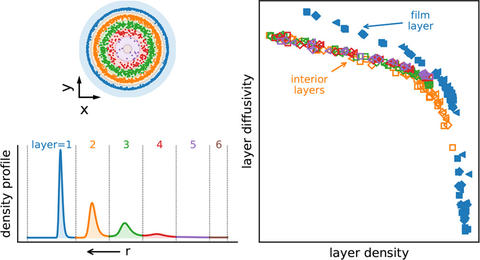Summary
It is well known that the physical properties of a fluid can change profoundly, and often non-trivially, when placed in a confined environment. Only for the simplest of fluids do there exist theoretical approaches (e.g., classical density functional theory) that can predict confinement-induced changes in fluid structure and thus thermodynamics. Unfortunately, no such theoretical tools exist for predicting the effect of confinement on dynamic properties, thus limiting our understanding of emerging technologies that operate at molecular length scales. Given this lack of knowledge, even simple heuristics should have some practical utility. To this end, we perform comprehensive computational studies of simple fluids in confinement to investigate the connection between static and dynamic fluid properties. Perhaps the most salient finding of this work is that the relationship (correlation) between available space and diffusivity in simple fluids is surprisingly insensitive to the degree of confinement and confining geometry (and composition, in the case of binary mixtures) over an enormous range of state points spanning from the dilute gas to the supercooled liquid. For the hard sphere fluid, this robust relationship can be exploited to provide a simple procedure for predicting the diffusivity in confinement.
Description

Axial Diffusion in Pores is controlled by Local Density. From https://doi.org/10.1021/acs.langmuir.7b03401
The dynamic properties of bulk fluids remain a challenge to predict. Predicting the dynamic properties of confined fluids represents a greater scientific and engineering challenge. Developing simple heuristics or even robust correlations will be helpful in developing and understanding technologies that operate at increasingly smaller length scales.
Objective: To ascertain the effect of pore features (e.g., size, geometry, fluid-wall interactions) on correlations between dynamics and thermodynamics in bulk and confined single- and multi-component fluids spanning vapor and liquid densities. Eventually, we would like to extend this work to more realistic fluids.
Research Activities: We have calculated the self-diffusion coefficient using molecular dynamics, and excess entropy and various measures of available volume using transition-matrix Monte Carlo at approximately 1,000 state points, covering densities from the dilute gas to the freezing transition. The remarkably robust correlation between the available volume and diffusivity can be used to provide an accurate, fast simulation-free approach to estimate the self-diffusivity coefficient of confined hard-sphere fluids.
Major Accomplishments
We have discovered a remarkably robust correlation between the available volume and diffusivity. Exploiting this relationship, we have developed a fast simulation-free approach to estimate the self-diffusivity coefficient of confined hard-sphere fluids.
ASSOCIATED PUBLICATIONS
- Krekelberg, W. P. and Shen, V. K., "On the virial expansion of model adsorptive systems," Molecular Physics, 120, (2022).
- Monroe, J. I., Hatch, H. W., Mahynski, N. A., Shell, M. S., and Shen, V. K., "Extrapolation and interpolation strategies for efficiently estimating structural observables as a function of temperature and density," Journal of Chemical Physics, 153, (2020).
- Krekelberg, W. P., Mahynski, N. A., and Shen, V. K., "On the virial coefficients of confined fluids: Analytic expressions for the thermodynamic properties of hard particles with attractions in slit and cylindrical pores to second order," Journal of Chemical Physics, 150, (2019).
- Mahynski, N. A., Jiao, S., Hatch, H. W., Blanco, M. A., and Shen, V. K., "Predicting structural properties of fluids by thermodynamic extrapolation," Journal of Chemical Physics, 148, (2018).
- Krekelberg, W. P., Siderius, D. W., Shen, V. K., Truskett, T. M., and Errington, J. R., "Connection Between Thermodynamics and Dynamics of Simple Fluids in Pores: Impact of Fluid-Fluid Interaction Range and Fluid Solid Interaction Strength," Journal of Physical Chemistry C, 121, 16316-16327 (2017).
- Mahynski, N. A., Blanco, M. A., Errington, J. R., and Shen, V. K., "Predicting low-temperature free energy landscapes with flat-histogram Monte Carlo methods," Journal of Chemical Physics, 146, (2017).
- Siderius, D. W., Krekelberg, W. P., Chiang, W. S., Shen, V. K., and Liu, Y., "Quasi-Two-Dimensional Phase Transition of Methane Adsorbed in Cylindrical Silica Mesopores," Langmuir, 33, 14252-14262 (2017).
- W.P. Krekelberg, D.W. Siderius, V.K. Shen, T.M. Truskett, and J.R. Errington, "Connection between Thermodynamics and Dynamics of Simple Fluids in Highly Attractive Pores", Langmuir, 2013, 29(47), 14527-14535.
- W.P. Krekelberg, V.K. Shen, J.R. Errington, and T.M. Truskett, "Impact of Surface Roughness on Diffusion of Confined Fluids", J. Chem. Phys., 2011, 135, 154502.
- G. Goel, W.P. Krekelberg, M.J. Pond, J. Mittal, V.K. Shen, J.R. Errington, and T.M. Truskett, "Available States and Available Space: Static Properties that Predict Self-Diffusivity of Confined Fluids", J. Stat. Mech.: Theor. Exper., 2009, 2009(04), P04006.
- J. Mittal, V.K. Shen, J.R. Errington, and T.M. Truskett, "Confinement, Entropy, and Single-Particle Dynamics of Equilibrium Hard-Sphere Mixtures", Journal of Chemical Physics, 2007, 127(15), 154513.

